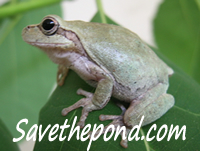 |
 |
|
|
Last Updated: 5/25/10
This is a list of ways to help wild frogs, toads, newts, and salamanders.
Please contact me if you have something to add to the list. Thanks.
1. Build an amphibian pond. See my amphibian pond page for more details.
2. Avoid using chemicals such as pesticides, herbicides, and fungicides anywhere but especially near amphibian breeding sites. Encourage your neighbors to stop the poisoning as well. Not only do chemicals kill amphibians outright, they also kill their prey (mostly insects) and, in some cases, cause mutations (extra legs, sex organ changes, etc.). Pesticides are dangerous for us humans too. Check out my organic pond page and Beyondpesticides.org.
3. If you have a swimming pool, discourage amphibians from using it and rescue them when they do. The chlorine used in most pools will harm amphibians and kill any eggs that they lay. You can build a ramp (just using something simple like a pool toy) to help amphibians get out of the water. Here is a link to a fake lily pad that may help small animals get out of a swimming pool: Frog Saver Lily Pad. Check pool skimmers a few times a day to remove any amphibians that get in there. If a lot of them end up in the pool, you can build a grate over the skimmer with some hardware cloth (rabbit wire) or something. Often, building a small pond away from the pool will keep frogs and other amphibians out of the pool.
4. Rescue amphibian eggs off the swimming pool cover if they lay eggs there during the spring. At our house, gray tree frogs lay eggs on the cover. I collect them and move them to my tub ponds. They can be moved to any pond that has a low predator population (few fish).
5. Join Frogwatch to contribute to research on what frogs are found where and how they are doing.
6. If you have a pond, make sure that any amphibians that you have that overwinter under water have the right conditions. This usually means a hole in the ice, aeration on the bottom, and a place to hide. See my page on helping frogs and toads to overwinter.
7. If you have a single pond with fish, consider building a smaller pond or tub pond for amphibians to use for reproduction. Many pond fish will eat most frog eggs and smaller tadpoles. They should not eat toad eggs or tadpoles because they taste bad. Fish that eat frog eggs and tadpoles include goldfish, koi, orfe, and mosquito fish. Smaller fish like native fathead and rosy red minnows are less likely to eat frog eggs and tadpoles.
8. Rescue tadpoles from water sources that are drying up before the tadpoles are ready to turn into adults.
9. Set up abodes for land-dwelling amphibians using clay pots, wood piles, mulch piles, ceramic houses sold for frogs and toads, plant cover, and other such things. The more variety of things [types of soil, types of ponds, types of plants, types of foods (live insects), types of hiding places, etc.] that are around, the more apt that something will be there to attract certain species and more species.

|
|
Return to the main amphibian page.
See the master index for the amphibian pages.

|

|
E-mail RobynCopyright © 1997-2025 Robyn Rhudy |

|
 |